Week of Weed-Whacking
Illegal Marijuana Fields Exhibit New Cultivation Methods
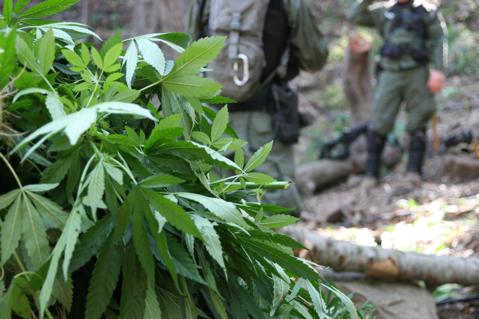
‘Tis the season to get rid of illegal marijuana grows in Santa Barbara county, and narcotics officers were kept busy last week as they pulled up thousands of pot plants hidden on remote hillsides and nestled in deep, backcountry canyons.
The annual countywide raid — which typically takes place in these late summer months, as farmers are either in the midst or preparing for harvest — yielded 91,000 plants that’d be worth nearly $200 million on the street. Some of the dozen or so sites were discovered on private property, but the vast majority were situated in US Forest Service land so inaccessible officers had to be airlifted and dropped in. No one was arrested.

Surprising to Lieutenant Sonny LeGault — who’s coordinated such raids for the last three years — was the level of planning and sophistication exhibited in some of the gardens. Growers usually tend to a single crop that matures throughout the year, and sometimes coordinate multiple harvests in different plots that are in varied levels of growth. But this time LeGault’s team found four plants of different ages within the same plot, meaning farmers were hoping to cultivate year-round in a single, more compact space. “I’ve never seen that before,” he said.
Around 30 law enforcement personnel took part in the forays, including members of the Santa Barbara County Sheriff’s Department’s Special Investigations Division and a handful of state drug enforcement personnel from the Campaign Against Marijuana Planting (CAMP) initiative.
The first bust went down on Thursday, July 22, in a rugged canyon east of Mariposa Reina on the Gaviota Coast. Authorities were tipped off to the grow, said LeGault, by a hiker who stumbled into the garden but quickly left and contacted officers. There was also suspicion that the burned body found nearby on the Nojoqui Grade on July 15 may have been connected to the illegal operation. But LeGault said that theory has been ruled out, despite reports in the media stating otherwise. “Let’s get that straight,” he said.
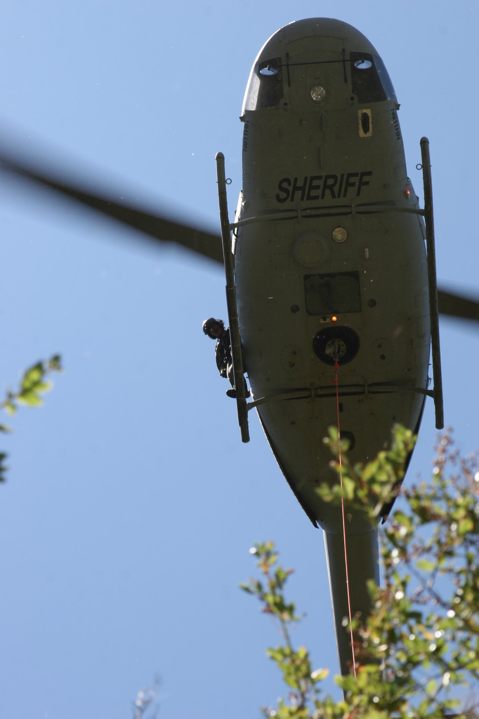
Then on Monday, July 26, LeGault’s crew hit four separate gardens (with a total of 19,00 plants), sprinkled for several miles around the Davy Brown Campground, close to Happy Canyon Road. On Tuesday, officers raided three gardens near Bear Creek, between Highway 154 and West Camino Cielo. Wednesday saw the eradication of five gardens in Romero Canyon, while two more were destroyed at Romero Saddle and Montecito Peak. On Thursday, said LeGault, the team then took out a large grow (17,000 plants) in a steep canyon on the north side of East Camino Cielo, just above Rancho Oso. And on Friday, authorities eliminated a number of fields at the end of South Refugio Road, just below West Camino Cielo in the canyons.
The grows, explained LeGault, had been tracked down and pinpointed over the course of the year. While some were identified through direct tips (like the Mariposa Reina site), others were spotted from helicopters during unrelated calls. And trained narcotics officers, he said, get extremely adept at spotting gardens from above during scouting missions, picking out the tell-tale signs and color differentiations that’d be invisible to the average person.
One of the targeted gardens last week was reportedly built four feet up on a plateau to match the height of surrounding vegetation. It had wire and bird netting strung around it, relayed LeGault, with leaves and branches placed on top to create a faux canopy. In other instances, growers have placed fields in the middle of close-standing trees, cutting just enough of a skylight in the above foliage to let in a bit of needed sunlight, and have been known to jerry-rig irrigation lines to run uphill.
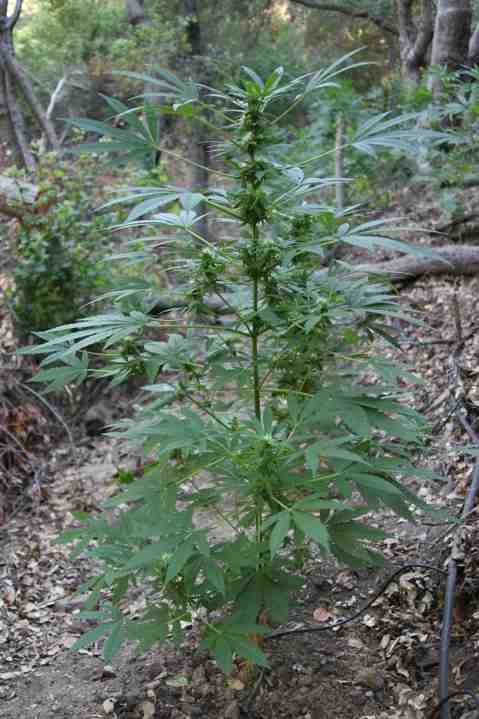
Plots on the small end of the size spectrum — and easily accessible from trails and roads — are sporadically destroyed over the course of the year. “We’ll get to gardens every once in a while,” said LeGault, “if they’re easy enough to get to or not too difficult a hike or not too large.” But bigger operations — like the ones from last week that were buried deep in canyons and dotted on remote hillsides, far removed from civilization — require a good deal of equipment, manpower, and coordination.
Because of that, it makes more logistical sense to “save up” the targeted grows until they can all be tackled in one fell swoop. “It’s easier and safer for us to pool resources and do these operations all at one time, and just dedicate the day or the week to getting as many as we can in that time period,” said LeGault. “We’ll clear our calendars — they’re very labor intensive to do.”
LeGault explained that his team was mainly composed of Sheriff’s personnel taken from their regular beats to participate in the multi-day operation, and that the effort’s total cost (including labor) tallied to around $100,000. Each full-grown plant is conservatively estimated to be worth around $2,000, he said, but in reality they’d likely fetch $4,000-$5,000 apiece on the street. The lieutenant said he uses the low-end figure to calculate total value because the numbers are impressive enough and speak to the profitability of the black market business. “You see how much money there is in this and why these organizations go to the efforts they do, and why these guys go to such remote areas,” he summed up.
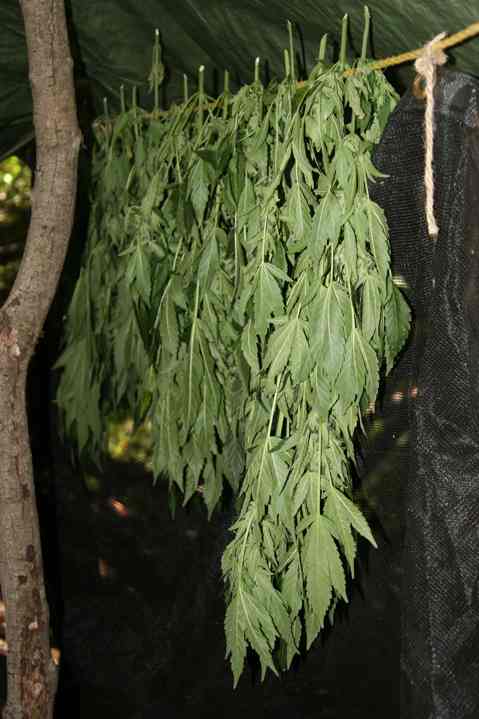
The men tending to the these marijuana fields, asserted LeGault, are all Mexican nationals. “Most of them are drug trafficking organizations based outside of this county,” he said. “They’re connected or loosely connected to cartels, and based on evidence we found at the camp and intelligence we’ve gotten before from people we’ve actually caught, all the grows [last] week were Mexican national grows.”
He said that the increasing popularity of tending marijuana fields in Santa Barbara’s countryside can be clearly linked to heightened security restrictions at the US/Mexico border in the wake of 9/11, explaining it’s easier for cartels to smuggle people over the border to tend grows than it is to transport the drugs themselves.
No one was taken into custody during last week’s missions, but LeGault revealed that outcome is typically by design. Oftentimes, authorities make it known to growers that they’re on their way in — swooping low with multiple helicopter passes before letting deputies rappel down — to avoid surprises and potential violent confrontations. “We make it known we’re coming,” said LeGault. “It’s just not safe…We don’t want those guys to be there.”

In some cases, though, teams do try to arrest the farmers by sending in heavily-armed SWAT crews. But even the most organized of operations usually fail to turn up any suspects, as the growers create elaborate escape routes that allow them to easily disappear into the thick chaparral. During the Mariposa raid, said LeGault, authorities tried to box in a group of suspects they knew were on-site — planning on using the steep canyon slopes as a natural barrier and taking control of what they thought was the only trail around — but the growers were able to slip through their fingers by dashing onto a path the deputies didn’t know existed. “It’s really difficult,” lamented LeGault. “You’d need a couple battalions to surround things to try and catch four or eight little guys.”
In addition to the helicopters flown by County Sheriff’s pilots — including a big, twin-engine Huey used this year for the first time — CAMP personnel brought in one of their own crafts. And this year, as opposed to past raids, authorities were able to collect and dispose of the massive amounts of trash and camping materials typically found in grow sites. “We’re usually out there all day and just don’t have the time and resources to get it all,” said LeGault. “We’ll try to take out the stuff that’s real damaging, but there’s usually a good amount that’s just left to sit in the watershed.”
LeGault explained that this time around the Forest Service brought in a stake bed truck and hauled out nets of trash, batteries, fertilizers, propane tanks, and so on. (The Sheriff’s Department, on contract with the Forest Service, also gets money from the federal organization because 90 percent of fields are within national forests.) The Huey is able to lift 10 times the weight of normal choppers and picked up bundles of trash, depositing them directly at the dump.
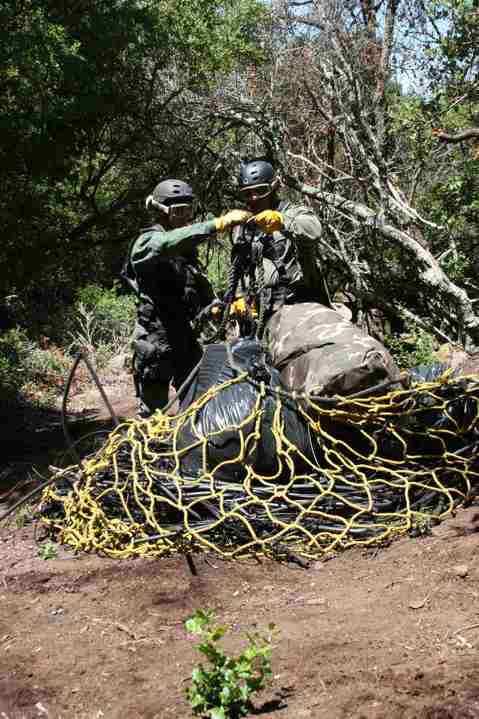
The importance of bagging the leftover mess is not to be underestimated, said LeGault, commenting on the significant environmental effects illegal grows have on area ecology. By damming up small creaks, running drip lines, and altering the landscape, he went on, growers make significant negative impacts on the countryside. “The environmental damage is almost as bad as the drug itself,” he claimed. Investigators recently said faulty equipment used by marijuana farmers near New Cuyama started last year’s La Brea Fire that scorched over 90,000 acres.
While LeGault has no illusions that his team will ever be able find and destroy every illegal grow in the county — “I’m sure there’s more out there,” he said, “and I’m confident that we’re not going to find it all. The county’s too large, there’s too many of these deep canyon streams and remote areas that we’re not going to see” — he’s sure they’re at least making a dent and sending message.
Last year the department had a record season — hauling out 200,000 plants — and LeGault is confident that those efforts will lead to less plants snagged this year. “Hopefully, [this year] we’ll be a little slower, and our efforts last year would have paid off,” he explained. “And efforts this year may even pay off again next year… The more effort we put in and the more times we’re successful in eradicating, the more it discourages [cartels] from coming into this county.”



